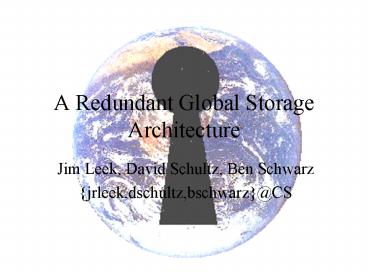A Redundant Global Storage Architecture - PowerPoint PPT Presentation
1 / 18
Title:
A Redundant Global Storage Architecture
Description:
A Redundant Global Storage Architecture. Jim Leek, David Schultz, Ben Schwarz ... More to recover when a disk is lost. Network Architecture ... – PowerPoint PPT presentation
Number of Views:72
Avg rating:3.0/5.0
Title: A Redundant Global Storage Architecture
1
A Redundant Global Storage Architecture
- Jim Leek, David Schultz, Ben Schwarz
- jrleek,dschultz,bschwarz_at_CS
2
Storage as a Service
- Many companies already provide access to massive
data sets as a service (e.g. Google) - Provide access to raw storage as a service
- Advantages
- Already know how to manage storage clusters
- More reliable than personal storage
- Available anywhere
- Disadvantages
- Security?
3
Storage as a Service
- Clients allocate large chunks of storage
- 64 MB for now
- Cost based on bandwidth and total space
- Bandwidth is most important
- Disk BW increasing at 40/yr, capacity at 60/yr
- Space costs money too
- Making data always available consumes power
- Backups
- More to recover when a disk is lost
4
Network Architecture
- Storage network is a collection of chunk servers
- Space allocation and deallocation is centralized
at the master - Stateless design simple recovery
5
Network/Translation Layer
Master Server (lookups) Chunk Server
(storage)
- Responsible for replicating
- Fault tolerant
- Higher bandwidth requests
- Buffers requests
- Central authority
- Small number
- Fault tolerant
- Low bandwidth
- Distributes load
- Block location cache
Forward bytestream
read write openIOGroup closeIOGroup
whoIsMaster
allocate free locateBlock
6
Filesystem Design
- Encrypted on the client side
- Always consistent
- Structured as a Merkle tree
- Copy on write
- Inexpensive snapshots reduce the impact of user
error - Block allocation/cleaning similar to LFS
- Local WAL to provide fast synchronous writes when
required
7
Updating a Block
8
Updating a Block
9
Updating a Block
10
Updating a Block
11
Updating a Block
12
I/O Model
- Servers provide no transaction support
- Servers only see encrypted data anyway
- xFS designers showed how to do isolation entirely
on the client side - Server respects WAW dependencies
- Clients attach each write to an I/O group
- Groups are committed in order
13
Security
Thread Model
CS
Attacks
CS
- MIM
- Deduce data loc.
- Timing attacks
- Statistical attacks
- Compromised CS?
Alice
CS
e.g. file size
Bob
CS
Improvement over existing architectures!
Even chunkservers are not in-the-know
14
Security II
- Filesystem - Encrypt data prior to storing.
Decrypt on retrieval. Not a fundamental
limitation of OceanStore. - How do we handle data that should be read by a
set of people (e.g. group privileges)? One public
key. Distribute multiple private keys. Use GPG!
DATA Privi(Pub(DATA)) Privk(Pub(DATA))
- Multiple private keys for member identification
- Or use a single private key for anonymity
15
Security Guarantees
- MACs guarantee that the server cant change the
data - Hypothetical attack server selectively ignores
writes, inconsistent versions trick the client - Merkle tree structure provides fork consistency
- Informally, if the server prevents clients A and
B from seeing each others updates, the clients
will either detect the problem or live in
parallel universes from then on - Freshness?
16
Conclusion
- Improvement in security and privacy over existing
architectures - Simple stateless server design makes recovery
easier - AFS and xFS have problems with recovery
- Virtually unconstrained write ordering should
provide good performance
17
Questions
18
Related Work
- OceanStore
- Distributed object location
- Google Filesystem
- Master/Chunkserver architecture
- LFS
- Large sequential writes
- WAFL
- WAL for synchronous semantics
- Tree of blocks for consistency































